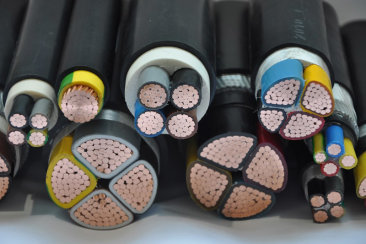The difference between Category 5 network cables and Category 6 network cables
Release time:
2023-11-17
1. The structure is different. The twisted pair cables in Class 6 network cables have a cross skeleton, and installing the cables inside the skeleton can provide a good insulation effect. Secondly, the copper cores of the two are different in size. The copper cores of Class 5 are below 0.45mm, while those of Class 6 are between 0.56mm and 0.58mm. In terms of appearance, the outer diameter of Class 5 network cables is thinner than that of Class 6 network cables. Class 5 network cables have the CAT5 logo on the outer surface, while Class 6 network cables have the CAT6 logo. 2. The wire cores are different. The diameter of Class 6 ranges from 0.56 to 0.58 millimeters, while Class 5 only has a maximum of 0.45 millimeters, which can be seen with the naked eye. The thickness of these two types of lines is different. 3. The identification is different. The outer packaging of Class 6 is labeled Cat6, while Class 5 is labeled Cat5. 4. Different performance. The transmission performance of Category 6 Ethernet cables is higher than that of Category 5. The transmission bandwidth of Category 5 network cables is 100MHz, while Category 6 network cables can not only adapt to 100MHz, but also transmit gigabit network speeds. In addition, the transmission performance of Category 6 Ethernet cables is also more stable than that of Category 5 Ethernet cables, as the cable crosstalk and echo loss of Category 6 Ethernet cables have been optimized. 5. Prices vary. In terms of sales price, because Category 6 Ethernet cables have advantages over Category 5 Ethernet cables in terms of material usage and performance, the price will be higher than Category 5 Ethernet cables. 6. The size of the copper core varies. The copper core size of Category 6 network cables and Category 5 network cables is different. The copper core size of Category 5 network cables is below 0.45mm, and the standard size for Category 6 network cables is 0.56mm-0.58mm. 7. The transmission bandwidth is different. Five types of network cables with a transmission bandwidth of 100Mbps are mainly used for data transmission in 100Mbps and 10Mbps networks; Category 6 Ethernet cables have a speed of over 1000Mbps and are mainly used in gigabit networks, with transmission performance far exceeding the Category 5 Ethernet cable standard. 8. The signal-to-noise ratio is different. The signal-to-noise ratio of Category 6 network cables is higher than that of Category 5 network cables, which means it can better resist external interference and maintain signal quality. This makes Category 6 network cables more suitable for high-speed data transmission and long-distance transmission. 9. Backward compatibility is different. Both Category 5 and Category 6 cables are backward compatible, which means they can be compatible with earlier versions of network devices such as switches, routers, etc.

1. The structure is different. The twisted pair cables in Class 6 network cables have a cross skeleton, and installing the cables inside the skeleton can provide a good insulation effect. Secondly, the copper cores of the two are different in size. The copper cores of Class 5 are below 0.45mm, while those of Class 6 are between 0.56mm and 0.58mm. In terms of appearance, the outer diameter of Class 5 network cables is thinner than that of Class 6 network cables. Class 5 network cables have the CAT5 logo on the outer surface, while Class 6 network cables have the CAT6 logo.
2. The wire cores are different. The diameter of Class 6 ranges from 0.56 to 0.58 millimeters, while Class 5 only has a maximum of 0.45 millimeters, which can be seen with the naked eye. The thickness of these two types of lines is different.
3. The identification is different. The outer packaging of Class 6 is labeled Cat6, while Class 5 is labeled Cat5.
4. Different performance. The transmission performance of Category 6 Ethernet cables is higher than that of Category 5. The transmission bandwidth of Category 5 network cables is 100MHz, while Category 6 network cables can not only adapt to 100MHz, but also transmit gigabit network speeds. In addition, the transmission performance of Category 6 Ethernet cables is also more stable than that of Category 5 Ethernet cables, as the cable crosstalk and echo loss of Category 6 Ethernet cables have been optimized.
5. Prices vary. In terms of sales price, because Category 6 Ethernet cables have advantages over Category 5 Ethernet cables in terms of material usage and performance, the price will be higher than Category 5 Ethernet cables.
6. The size of the copper core varies. The copper core size of Category 6 network cables and Category 5 network cables is different. The copper core size of Category 5 network cables is below 0.45mm, and the standard size for Category 6 network cables is 0.56mm-0.58mm.
7. The transmission bandwidth is different. Five types of network cables with a transmission bandwidth of 100Mbps are mainly used for data transmission in 100Mbps and 10Mbps networks; Category 6 Ethernet cables have a speed of over 1000Mbps and are mainly used in gigabit networks, with transmission performance far exceeding the Category 5 Ethernet cable standard.
8. The signal-to-noise ratio is different. The signal-to-noise ratio of Category 6 network cables is higher than that of Category 5 network cables, which means it can better resist external interference and maintain signal quality. This makes Category 6 network cables more suitable for high-speed data transmission and long-distance transmission.
9. Backward compatibility is different. Both Category 5 and Category 6 cables are backward compatible, which means they can be compatible with earlier versions of network devices such as switches, routers, etc.
Previous article
Previous article






